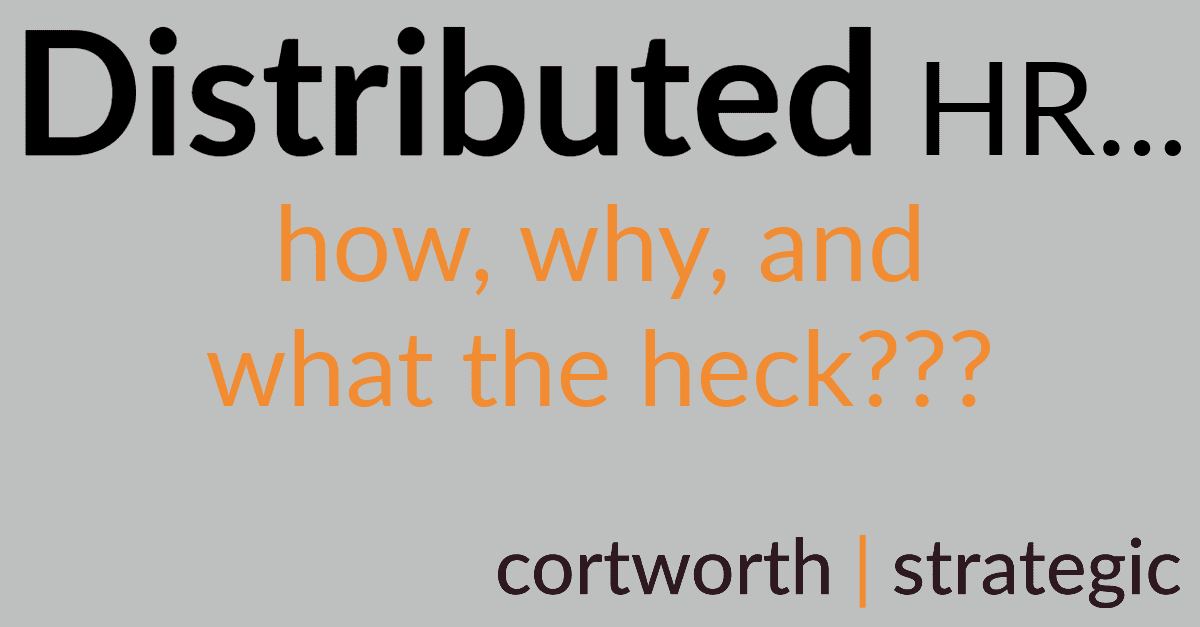Imagine a world where managers don’t just call HR for every challenge; but understand and proactively participate in HR some functions…
If this scenario sounds appealing, “distributed HR” may be your next strategic move – but don’t expect it to be easy.
What is distributed HR?
Traditional HR models are centralised, consolidating HR responsibilities in one dedicated (often harassed and overworked) HR department.
Distributed HR should decentralise some functions, delegating areas (or parts of areas) such as performance management, disciplinary and grievance handling, and absence management to line managers.
Distributed HR is popular as it offers enhanced responsiveness, alignment with business goals, and most compellingly it is a scalable model, something particularly appealing in high-growth businesses.
Though transitioning to distributed HR can bring challenges, it can also be a powerful tool for high-growth and post-M&A companies when planned and implemented carefully, supporting their evolution and promoting a more engaged and responsive HR framework.
Why introduce distributed HR?
High-growth and newly integrated companies following mergers and acquisitions (M&A) often face the demanding task of scaling their HR functions. A distributed HR model can help these organisations overcome such challenges by empowering managers, enhancing responsiveness, improving understanding of staff needs, and aligning HR with business goals more efficiently. The scalable nature of this model allows HR teams to concentrate more on strategic activities.

Which HR functions can be distributed, either in full or in part?
The potential for distribution varies across several HR functions, and depending of course on the potential of the managers concerned. Here are some ideas:
- Recruitment: Job posting, resume screening, interviewing, selection, and onboarding.
- Performance Management: Setting objectives, providing feedback, conducting performance reviews, and managing performance improvement plans.
- Learning and Development: Identifying training needs, scheduling training sessions, and tracking progress.
- Compensation and Benefits Administration: Explaining benefits packages to employees or managing compensation reviews.
- Disciplinary and Grievance Handling: First-level disciplinary issues and grievances can be handled by line managers, with serious or escalated issues referred to central HR.
- Absence Management: Line managers can manage sickness absence or annual leave within their teams, with HR providing guidance and managing the overall policy.
- Employee Engagement: Measures to improve employee morale, productivity, and retention like mentoring, staff feedback, social events, recognition etc.
- Health and Safety: Line managers could be responsible for implementing and monitoring safety measures in their respective areas, while overarching responsibility remains with central HR.
Choosing the degree of distribution for these functions will determine the required training effort for managers. It might be prudent to focus on one key area, such as absence management, before decentralising other functions.
Implementing distributed HR – planning, planning and planning
Board buy-in
Prior to undertaking this significant cultural change, it is crucial to secure full board backing. Anticipate possible resistance, misunderstandings, and employee turnover during this transition and ensure active support from the top level. This will involve a detailed plan being drawn up and presented to the board so that they are fully informed on potential benefits and risks. Clearly, there is the potential for “turbulence” from some employees who don’t wish to change and this can present legal challenges which need to be understood from the get-go.
Review contracts and policies
A shift to a distributed HR model can alter the performance of HR functions within a company, potentially impacting the roles and responsibilities of managers and employees, often defined in employment contracts, job descriptions, or even emails between employees and managers. It’s crucial to review these documents to ensure they reflect changes and remain legally compliant.
Key contractual terms and non-contractual agreements that may be affected include for example job descriptions, reporting lines, and working hours or locations, especially if the model incorporates flexible working practices or HR tech enabling remote working. Also, consider the impact of differing employment laws in multiple jurisdictions if your company operates internationally.
Manager audit
Before implementing a distributed management, it is prudent to conduct a systematic audit of your current team to identify who has the potential to step up in this way and who does not. Not all managers will be suited to handling HR functions, and some may lack the necessary skills, inclination, or time to fulfil these roles effectively.
You will need to consider the impact of any specific disabilities among management. Some disabilities for example autism may require reasonable adjustments to be implemented for the employee.
If you are interested in implementing a distributed HR model in your business and would like help with the planning and implementation, email us today. https://cortworthstrategic.com/contact/
Manager training and other support
Subsequent to the audit, you will need to design a comprehensive training plan for the managers. It is insufficient to provide a one-off video and expect managers to be able to undertake a disciplinary hearing for example.
Generally speaking, this training should cover areas like employment law, performance management, absence management, recruitment, and employee relations. In addition to training ongoing support, reference resources, and coaching from HR teams will be essential for their success.
You will need to consider and adjust your staff handbook. Consider for example the dividing line between a minor misconduct issue that a manager may competently deal with, and on the other hand, a complex harassment allegation which should certainly remain the preserve of central HR.
Communication and employee buy-in
Transparency is essential when introducing any organisational change. The reasons for the shift to distributed HR, what changes to expect, and how these will impact employees and managers need to be communicated properly. Encourage dialogue to answer queries and address any concerns from both managers and employees.
Legal compliance
Ensure your distributed HR model meets all legal and regulatory obligations, including those relating to privacy and data security, particularly if it involves the use of HR tech. Non-compliance can result in severe penalties and reputational damage.
HR technology
HR technology can (and normally does) play a significant role in enabling the distributed HR model. It can facilitate remote working, improve accessibility, streamline processes, and deliver analytics for improved decision-making. Carefully select your HR tech solutions to meet your specific needs and ensure they are user-friendly to encourage adoption.
Monitoring and feedback
Implement a system to monitor the effects of your distributed HR model, collecting regular feedback from managers and employees. This data will allow you to assess the success of the model, identify potential issues and make necessary adjustments.
The path to distributed HR
Implementing a distributed HR model can offer a wealth of benefits, including increased HR efficiency, better alignment with business goals, improved manager-employee relationships, and more resilient and responsive HR functions.
The journey will inevitably involve challenges and risks, from resistance to change, through the need for retraining, to potential legal implications. However, when implemented with care and attention, distributed HR has the potential to revolutionise the HR landscape in high-growth and post-M&A companies.
Taking the time to secure board buy-in, review policies, audit and train managers, communicate effectively, ensure legal compliance, select appropriate HR tech, and monitor results, can help ensure a successful transition to this empowering and responsive model.
With careful planning, distributed HR can bring about strategic HR value that is hard to achieve in a centralised model, enabling companies to better meet the evolving demands of the business environment and effectively manage their most valuable resource – their people.
